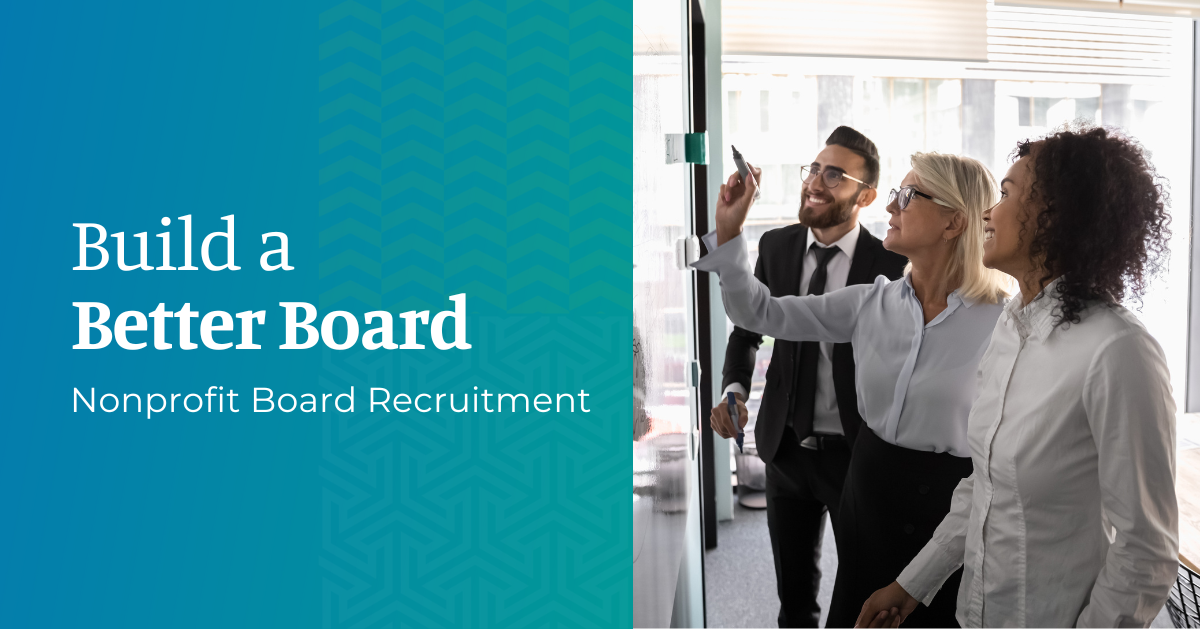Effective boards are a result of the alchemy of many factors: advocacy, engagement, securing resources and giving gifts, strategic thinking and planning, asking hard questions, supporting the leadership, not getting in the weeks or meddling with staff decisions, and camaraderie and respect amongst the board members themselves, just to name a few.
But those factors can’t lead to success without the key ingredient: recruiting great board members to begin with.
How do you recruit active, engaged board members?
Board recruitment is very similar to the donor cultivation process; identification and qualification of prospects, building and deepening engagement with your organization, and finally an invitation to join the board.
New board members should already be engaged with the organization to some degree. Whether as a donor, volunteer, event attendee, or someone who has offered assistance in the past, organizations need to ensure that their board members actively care about their organization and have demonstrated that in some way.
Recruiting a board member who has not had any involvement with the organization can work, but it is important to be very deliberate in your selections, engagement, invitation and then orientation to ensure that new board members are fully committed to your goals and will be active and constructive members.
To identify these potential board members, first look among folks who are already connected to your organization in some way. For example:
- Fundraising or program staff can identify a good prospect through their own interactions with the individuals through their gift giving, volunteering, or in other ways
- Board members can connect their colleagues or acquaintances to the organization or the ED/CEO
- Executive Directors may suggest individuals
Second best is looking for new people with whom you can engage in your mission for eventual board placement further down the line. Some places to start are:
- Websites and organizations that help introduce those who would like to serve on a board with organizations looking for board members
- Boards can ide ntify individuals who are part of specific community, civic group, or company that the organization wants to develop stronger ties to, then look for connectors to those individuals
- Fundraising staff can look through business publications to identify philanthropic individuals who are involved in other (perhaps similar) institutions
Who recruits new board members?
The best practice is to have an active board committee whose responsibility includes recruiting and orienting new board members. You may choose to have a dedicated nominating committee, focused solely on identifying, recruiting, and orienting new board members, or a board development committee that is responsible for overall board engagement and performance.
No matter how they “source” new members, this committee should take this job very seriously and engage in the recruiting process year round.
Who makes a good board member?
Different organizations have different needs, and analyzing what your current situation calls for should be done prior to recruiting your new members, by looking at your current board’s assets and experiences, and seeing what gaps you already have, or will have as individuals roll off your board.
A simple approach to start with is to create a matrix that lists all of your desired qualities for your board (professional backgrounds, philanthropic experience, demographics, constituents, etc.) and map your current board members against that. You’ll notice what you are missing.
Nonprofit board member responsibilities can vary depending on your organization. Here are some general areas to consider:
- Some newer or smaller organizations may need specific skills –such as law, finance, or marketing– to help them operate more effectively. These are “working boards” that do some of the actual work of the organization while it is growing and increasing staff capacity.
- Depending on the mission of the organization, many boards seek to incorporate representatives of the communities that they serve. For example, Federally Qualified Health Centers (FQHC’s) are required by law to have 51% community/client representatives, while others want to include community representatives as a natural outgrowth of their mission and vision.
- Relatedly, we urge organizations to actively seek input and leadership from individuals from racially, economically, and culturally diverse points of view and lived experiences to improve the quality of its strategic decision-making as well as day-to-day tactics and plans.
- All organizations need some board members with both financial capacity AND philanthropic inclination (having the first without the second will only lead to frustration). Ensuring the organization has sufficient resources is one of the primary jobs of a board member, and it is important that some directors/trustees can make major gifts and/or have access to those who can. You also need board members who are either already comfortable with fundraising for the organization or are willing to learn.
So you’ve recruited individuals who are energized by your mission, bring valuable and diverse opinions to the board, and can help secure resources. Are you done?
Actually, you are never done until board members roll off the board (and even then you should keep them engaged in your work), but the next and often overlooked step is to formally orient the new members to the board and your organization prior to their first board meeting.
Board Orientation
The last big step of effective recruitment is conducting an effective orientation for new board members so they start on as firm a footing as possible.
Things to remember in designing your orientation plans:
- Who should they meet? Executive Director, Board Development Committee Chair, other new board members, senior staff.
- What should you cover? Review the job description, including the giving requirements, key board policies such as conflict-of-interest, the organization’s financial statement, board committees, and main program areas.
- Include some social time in their orientation to start fostering the respect and relationships that make an effective board in action from the beginning.
Finally, set new board members up for success by assigning them a “board partner” to meet them prior to their first board meeting, be available for questions, and periodically check in to see if they have questions or concerns.
It is critical to keep in touch with your board members throughout their entire tenure, engaging them in your mission through important committee work, fundraising and education, but with a thoughtful approach to recruitment and orientation you will enjoy a solid footing for a powerful and productive relationship.




Comments
Questions or comments? Join the conversation!